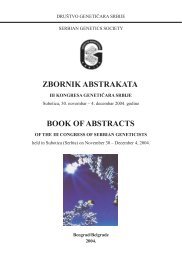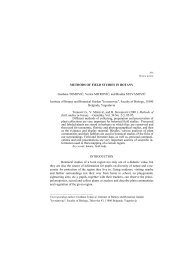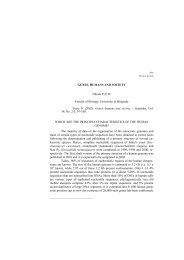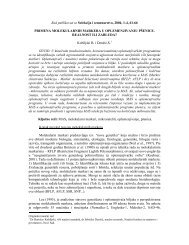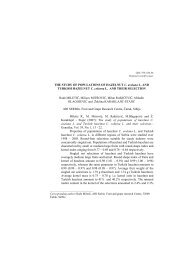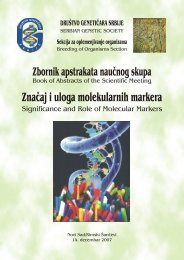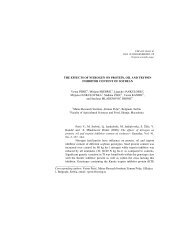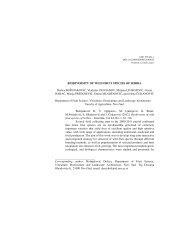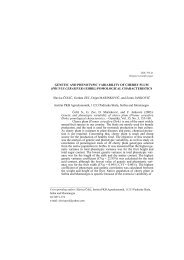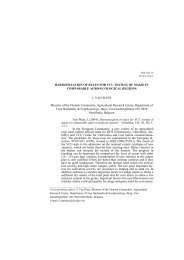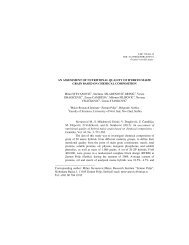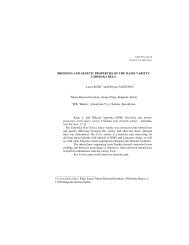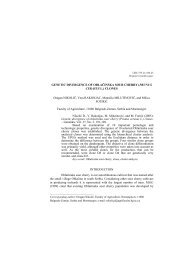Initial and final fruit set in some plum (Prunus domestica L.) hybrids ...
Initial and final fruit set in some plum (Prunus domestica L.) hybrids ...
Initial and final fruit set in some plum (Prunus domestica L.) hybrids ...
You also want an ePaper? Increase the reach of your titles
YUMPU automatically turns print PDFs into web optimized ePapers that Google loves.
584 GENETIKA, Vol. 44, No.3, 583-593, 2012<br />
abundance. Generally, the results suggest lower flower<strong>in</strong>g abundance <strong>in</strong> the<br />
second year of the study. Pollen germ<strong>in</strong>ation ranged from averagely 25.31%<br />
(29/29/87) to 40.01% (38/62/70). With averagely 31.59% <strong>f<strong>in</strong>al</strong> <strong>fruit</strong> <strong>set</strong><br />
under self-poll<strong>in</strong>ation <strong>and</strong> 29.38% under open poll<strong>in</strong>ation variants,<br />
respectively, hybrid 34/41/87 gave the best results. The lowest performance<br />
was observed <strong>in</strong> hybrid 32/21/87 with 1.61% <strong>and</strong> 7.69% <strong>f<strong>in</strong>al</strong> <strong>fruit</strong> <strong>set</strong> under<br />
self- <strong>and</strong> open poll<strong>in</strong>ation variants, respectively.<br />
Key words: flower<strong>in</strong>g, <strong>fruit</strong> <strong>set</strong>, <strong>plum</strong>, pollen, promis<strong>in</strong>g <strong>hybrids</strong><br />
INTRODUCTION<br />
Plum is an important <strong>fruit</strong> species, <strong>in</strong>terest<strong>in</strong>g for various forms of <strong>in</strong>dustrial<br />
<strong>and</strong> domestic process<strong>in</strong>g, <strong>and</strong> for fresh consumption. Grown on the area of 135,632<br />
ha <strong>and</strong> with an average annual production of 419,813 t (over 2000–2007, FAO<br />
Statistic Division, 2009), European <strong>plum</strong> (<strong>Prunus</strong> <strong>domestica</strong> L.) is a lead<strong>in</strong>g <strong>fruit</strong><br />
species <strong>in</strong> Serbia (MRATINIĆ et al., 2006), provid<strong>in</strong>g Serbia the fourth rank<strong>in</strong>g <strong>in</strong> total<br />
production on global scale (MILOŠEVIĆ et al., 2010).<br />
Plum belongs to Rosaceae family, Prunoideae subfamily, <strong>and</strong> Prunophora<br />
subgenus which <strong>in</strong>cludes a number of different species of <strong>Prunus</strong> genus. The bestknown<br />
<strong>and</strong> most widely grown species are <strong>Prunus</strong> <strong>domestica</strong> L., <strong>Prunus</strong> salic<strong>in</strong>a<br />
L<strong>in</strong>dl., <strong>Prunus</strong> subcordiata Benth. <strong>and</strong> <strong>Prunus</strong> <strong>in</strong>stititia L. (VOĆA et al, 2009).<br />
European <strong>plum</strong> (<strong>Prunus</strong> <strong>domestica</strong> L.) is a hexaploid <strong>fruit</strong> species (2n=6x=48),<br />
orig<strong>in</strong>at<strong>in</strong>g from natural cross<strong>in</strong>g of <strong>Prunus</strong> sp<strong>in</strong>osa (4x) <strong>and</strong> <strong>Prunus</strong> cerasifera (2x)<br />
genera (DECROOCQ et al., 2004; ILGIN et al., 2009).<br />
Self-fertility, ability to <strong>set</strong> <strong>fruit</strong> follow<strong>in</strong>g self-poll<strong>in</strong>ation, is an important<br />
trait <strong>in</strong> many <strong>Prunus</strong> species that contributes to higher, more consistent yields. Most<br />
<strong>Prunus</strong> <strong>fruit</strong> tree species exhibit a homomorphic gametophytic self-<strong>in</strong>compatibility<br />
(GSI) system, <strong>in</strong> which specificity of self/nonself-recognition is controlled by<br />
products encoded with<strong>in</strong> the S locus; <strong>in</strong> the poll<strong>in</strong>ation event, a self-<strong>in</strong>compatibility<br />
(SI) reaction is triggered when the same S allele specificity is expressed <strong>in</strong> both the<br />
pollen <strong>and</strong> pistil (TAO <strong>and</strong> IEZZONI, 2010). Dur<strong>in</strong>g the last two decades, much<br />
progress has been made <strong>in</strong> underst<strong>and</strong><strong>in</strong>g of the molecular basis of the gametophytic<br />
self-<strong>in</strong>compatibility system <strong>in</strong> <strong>Prunus</strong> species – sweet <strong>and</strong> sour cherry, almond,<br />
apricot, <strong>and</strong> <strong>plum</strong>. While diploid <strong>plum</strong> types are ma<strong>in</strong>ly self-<strong>in</strong>compatible, fertility<br />
level of European <strong>plum</strong> varies between self-fertility, partial self-fertility <strong>and</strong> self<strong>in</strong>compatibility<br />
(SZABÓ, 2003). In this l<strong>in</strong>e, the important factor for successful <strong>plum</strong><br />
grow<strong>in</strong>g is ga<strong>in</strong><strong>in</strong>g knowledge on a degree of self-fertility of a cultivar (NIKOLIĆ <strong>and</strong><br />
MILATOVIĆ, 2010). HEGEDUS <strong>and</strong> HALASZ (2006) report that almost half the total<br />
number of cultivars with<strong>in</strong> this species are self-sterile.<br />
On the other h<strong>and</strong>, knowledge of flower<strong>in</strong>g time of <strong>plum</strong> cultivars is<br />
essential for an adequate choice of cultivar comb<strong>in</strong>ation that ensures the most<br />
effective poll<strong>in</strong>ation <strong>and</strong> fertilization for abundant <strong>fruit</strong> <strong>set</strong>. Successful poll<strong>in</strong>ation<br />
<strong>and</strong> fertilization is one of the most important factors affect<strong>in</strong>g the f<strong>in</strong>ancial outcome<br />
<strong>in</strong> commercial <strong>fruit</strong> grow<strong>in</strong>g (KOSKELA et al., 2010).



